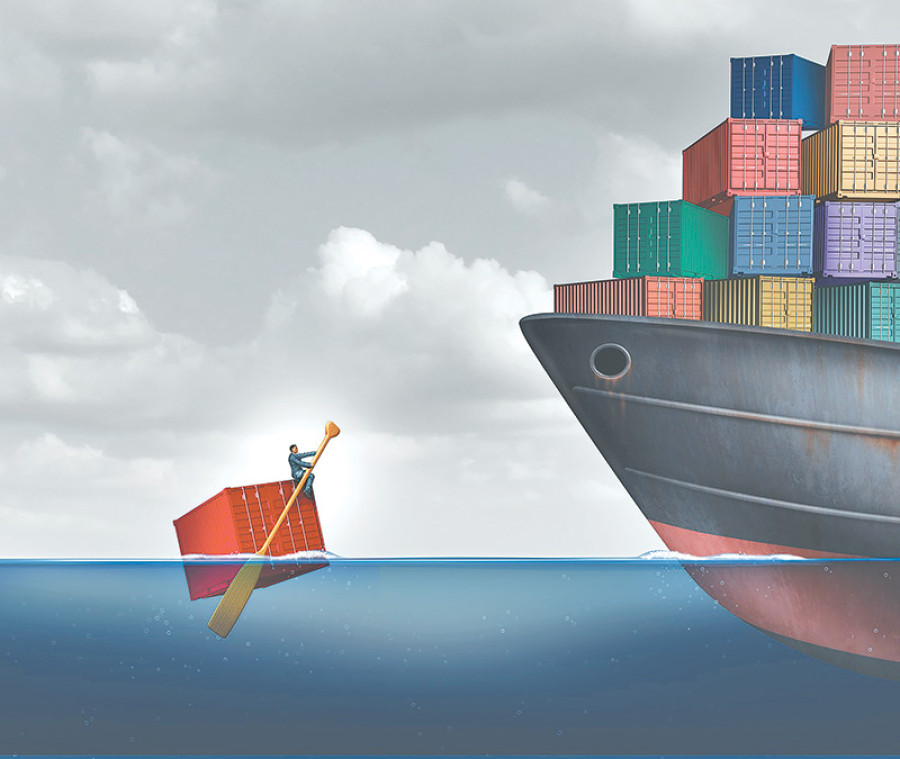Opinion
Cut imports, cut deficit
The runaway trade deficit cannot be checked without radical steps to reduce imports
Bijendra Man Shakya
The problem of Nepal’s growing trade deficit has gotten out of hand. From a deficit of Rs150 billion a decade ago, it ballooned sevenfold to a whopping Rs1,161 billion in fiscal 2017-18. Compared to last year, it has surged more than 30 percent. The figure is equivalent to more than 50 percent of the country’s current Gross Domestic Product (GDP). It is indeed a phenomenal growth, threatening the country’s other macro-economic indicators.
Early this year, the Ministry of Commerce proposed a work plan with the objective of managing this acute problem following the government’s aim to produce a white paper last year. The work plan incorporated many things which were neither original nor specific. It included vague measures to control and substitute imports. Additionally, it contained programmes to promote exports through investment promotion and technology transfer, protect intellectual property rights, develop special economic zones (SEZs) and provide cash and tax incentives to exporters and so on. But the plan unravelled as it was too ambitious and virtually impossible to fulfil in the short run.
Key reasons
There are other key reasons behind Nepal’s failed bid to curb its swelling trade imbalance by promoting exports. Like in other poor countries, Nepal’s export base is so narrow that it depends overly on two or three products which are not really dynamic in terms of global demand. In fact, demand for such products has shrunk due to intense competition among similar economies. But domestic policy intervention, instead of assuring an enabling trading environment, discouraged exporters who were baffled by a rapidly changing global business climate.
This suggests that Nepal’s trade deficit cannot be reduced instantly without taking some radical steps. The measures will seem to be harsh in the short run, but the situation will improve in the long run. In that sense, intervention may have to depart from the conventional thought of promoting exports, and adopt a combination of measures related to both exports and imports.
Import control measures can involve both import restrictions and import substitution. Import restrictions should be imposed without prejudice on products which are causing the trade imbalance so that the outcome is realised immediately. Restrictions may target the import of products such as vehicles and spare parts which have increased enormously and have a multiplier effect on the deficit. The higher the import of vehicles, the higher the import of gasoline needed to run them which has emerged as the single largest import value. Imports of these products, which account for a large chunk of the country’s import bill, jumped 36 percent compared to last year.
It is not easy to regulate imports by intervening in the import tariff structure. Since consumers will bear the burden of higher import duties, an indirect approach can be adopted without tampering with the import tariffs. The most appropriate way would be for the government to control hire-purchase schemes which have artificially induced consumers to buy such products even though there is no effective demand for them. So, if implemented, this intervention will bring some immediate positive impact.
Another way to stem imports would be to introduce an import substitution policy, but this should not be done immaturely like the government’s work plan had done. It should be planned carefully to produce effective results and as a long-term goal. The policy will take time to replace imports with domestic production. This applies specifically to two major sectors which have been depending excessively on imports, but can shift to domestic production. These two key sectors are energy and agriculture.
Import substitution
First, let’s examine the probable link between energy and import substitution. Hydropower can potentially replace imported cooking gas and petroleum products for industrial use. Fuel imports have grown tremendously, contributing to about one-fifth of the country’s total import value. More importantly, imports have grown so rapidly that they witnessed a 40 percent growth last year compared to the previous year. Therefore, the government should coordinate with line ministries and prioritise this concept instead of chanting the import substitution mantra without serious thought.
The second important step is to revolutionise the agriculture sector. The country’s food import bill has grown exponentially, crossing the Rs40 billion mark in 2017-18 from Rs12 billion just five years ago. Without wasting much time, two things need to be done. Besides dampening competition from imported subsidised food, the country’s farmlands lying fallow should be tilled. Subsidising agriculture may be the way to encourage farmers to cultivate their fields. But it is equally important for the government to assure farmers that they will get infrastructure and inputs, including farm labour. These measures were not included in the government plan that was unveiled last July with the aim of replacing food imports.
The problem of trade deficit is not a rare phenomenon. It is a sensitive macro economic issue for most countries. Sometimes, it can lead to trade disputes between a deficit country and a surplus country owing to protectionism. But for a vulnerable and trade dependent economy like Nepal, the reason behind this is different. The problem in Nepal is not foreign protection against its exports; the problem is a craving for uncontrolled imports. So, is the government, which is excessively dependent on import tariffs for its revenue, prepared to take harsh steps to regulate imports instead of messing around with futile policies to control the trade deficit?
Shakya is an associate professor of economics at Tribhuvan University.




 14.12°C Kathmandu
14.12°C Kathmandu










